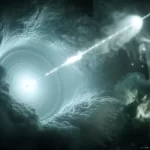Key Takeaways:
- The universe’s existence is divided into five distinct eras: Primordial, Stelliferous, Degenerate, Black Hole, and Dark.
- Our current phase, the Stelliferous era, began with the Big Bang around 13.8 billion years ago, marking the birth of stars and galaxies.
- Stars formed from dense gas pockets collapsing and undergoing nuclear fusion, with larger stars burning out quickly while smaller ones last longer.
- The future includes the merger of the Milky Way and Andromeda galaxies, the Sun’s transformation into a red giant, and the eventual Degenerate era dominated by remnants of stars.
- Ultimately, the universe will enter the Dark era, with dissipating black holes and extremely weak particles, leading to a cosmic blackout.
Step beneath a clear, moonless night sky, and you’re welcomed by a breathtaking canvas of stars—an intricate tapestry of lights stretching across space and time. This cosmic vista belongs to the Stelliferous era, one of five distinct phases that define the universe’s narrative.
Conceptualized by astronomers Fred Adams and Gregory Laughlin, these eras—Primordial, Stelliferous, Degenerate, Black Hole, and Dark—offer a framework for comprehending the universe’s evolution, starting from its enigmatic beginnings around 13.8 billion years ago with the Big Bang.

The universe’s dawn, the Primordial era, remains a theoretical realm, shrouded in the uncertainties of the Planck Epoch. It’s a period where space-time and physics as we know them might not have existed. Inflation, a rapid expansion mere moments after the Big Bang, set the stage for the formation of atoms and the emergence of cosmic background radiation.
The Stelliferous era, our current epoch, is the age of stars and galaxies. Stars birthed from collapsing gas pockets, each with a finite lifespan determined by its size. The grandeur of these stellar giants eventually collapses into supernovas, seeding the formation of newer, smaller stars and the birth of galaxies.
However, this era is fleeting. In about 4 billion years, the Milky Way will merge with Andromeda, leading to the formation of the Milkomeda galaxy. Following this cosmic event, our sun will enter its red giant phase, altering the fate of our solar system.

The subsequent Degenerate era marks the dominance of star remnants—white dwarfs, brown dwarfs, and neutron stars. With the gradual depletion of hydrogen, the universe dims, and black holes grow as remnants feed them.
In an unimaginably distant future, black holes will linger as the last remnants, slowly evaporating over vast timeframes, leaving a universe comprising feeble particles and fading photons. Eventually, the universe will succumb to darkness, marking the closure of its lifecycle.
Gazing at the stars tonight is a reminder of our temporal fortune, situated in a vast expanse of time. Despite the challenges, we reside in an era with an abundance of cosmic wonders, where the stars remain a constant, illuminating our nights and our imagination.


